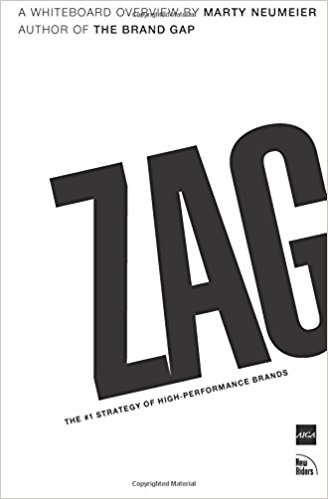Marty Neumeier “ZAG the number one strategy of high-performance brands” describes a new approach in branding that the author calls a ZAG.
Nowadays, the market is overloaded with a large number of identical offers of goods and services, it is becoming increasingly difficult for the consumer to make his choice. Therefore, it is very important for companies to offer the consumer something “different” to stand out from the crowd.
The author gives a new rule: when everyone does ZIGs, ZAG, that is, oppose yourself to others, but so skillfully that you are chosen. ZAG is not just a differentiation, but a radical differentiation.
To introduce a radical differentiation, Marty Neumeier offers to go through 4 steps:
- Finding your ZAG
- Designing your ZAG
- Building your ZAG
- Renewing your ZAG

The book consists of 3 parts in which these stages are disclosed in detail.
Part 1. Finding your ZAG
The secret to finding ZAG is a white space or a new market space. To find ZAG, you need to look for ideas that combine the qualities of the good and the different. The author gives for this purpose a matrix “good- different “.
Part 2. Designing your ZAG
The author offers to design and build ZAG to answer us 17 questions, which he calls the checkpoint. Each checkpoint faces one of 4 key elements: difference, focus, trend, and communications. All questions are described in detail and accompanied by successful examples of implementation.
The checkpoints:
1-Who are you? – What is your passion besides earning money?
2-What do you do? – This is something that will never change in your business. Write down your idea using no more than 12 words.
3-What is your vision? – This is a picture of the future in which the whole company believes.
4- What wave are you riding? – Make a list of trends that will support your success.
5- Who shares the brandscape? – Come up with a strategy that will help you become number one or two, or become a pioneer in a new category.
6- What makes you the “only”? – Name one thing that makes your brand exceptional and influential.

7-What should you add or subtract? – There should be no contradiction between what you say and what you do. The shortest route to your ZAG is to see what competitors are doing and do something different. Really different.
8-Who loves you? – A brand is an element of an ecosystem where each participant brings something to it and receives something from it. Draw a diagram of your business ecosystem. Determine what each participant brings to it and what they sacrifice.
9-Who is the enemy? – Instead of trying to satisfy everyone, risking not to please anyone, step forward and take the fight. Just make sure that your opponent will be the biggest and most successful competitor. The goal is to use the principle of contrast and sharply highlight your ZAG.
10-What do they call you?
A name should be:
- different than those of competitors
- brief –four syllables or less
- appropriate, but not so descriptive that it sounds generic
- easy to spell
- satisfying to pronounce
- suitable for “brandplay”
- legally defensible
11-How do you explain yourself? – It’s your valuable statement, the reason the brand means something to your customers. One brand – one statement. What offer can you describe your brand?
12- How do you spread the word? – Now we need to reveal the content hidden behind all these words, and spread it through various points of communication with the client – places where people come into contact with our brand.

13-How do people engage with you? – Compare your valuable offer with the offer of competitors. Determine which areas of competition you can completely avoid. Open the points of communication with the client, in which you will not find resistance.
14-What do they experience?– Without proper implementation, the company’s strategy will remain only a plan, an intention. The idea is to create impressions and experiences that will delight your customers – the people who determine the value and significance of your brand.
15-How do you earn their loyalty? – Loyalty will be mutual only after customers feel the loyalty of companies.
16-How do you extend your success? – How will you support the development of the brand year after year?
17-How do you protect your portfolio?
There are 4 dangers for the brand portfolio:
- contagion
- confusion
- contradiction
- complexity
Part 3. Renewing your ZAG
In this part, the author describes the principle of “scissors- paper-rock”. A “Scissors” company is a startup or a small business, most often owning one brand, have a very clear focus. A “Rock” company is a medium-sized organization, which has a large number of brands and a smaller focus. A “Paper” company is distinguished by their huge size, even more, brands, and less focus.

Any company has its maximum size limit. At this point, the company is committed to its own renewal by completing the cycle of competition – preparing the ground for future “scissor” companies. It refocuses, separates some areas of business and turns them into independent companies.
The main problem in building a brand is to create a complex organization to implement a simple idea. You need to launch new brands into white spaces, while central brands quietly exist at their own pace.
“ZAG the number one strategy of high-performance brands” is written in a light, not overloaded with terminology language. In the end, there is a list of recommended reading with an explanation for each book, and also for consolidating the material, the author gives brief conclusions to remind the reader some important points.
PS: if you need another approach to marketing I recommend to read Lateral Marketing by Kotler.





